Related Research Articles

Germanite is a rare copper iron germanium sulfide mineral, Cu26Fe4Ge4S32. It was first discovered in 1922, and named for its germanium content. It is only a minor source of this important semiconductor element, which is mainly derived from the processing of the zinc sulfide mineral sphalerite. Germanite contains gallium, zinc, molybdenum, arsenic, and vanadium as impurities.
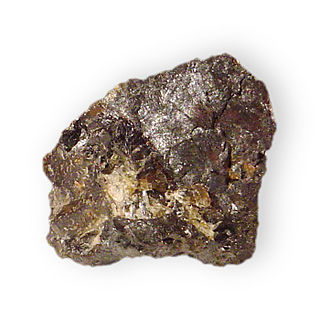
Zinkenite is a steel-gray metallic sulfosalt mineral composed of lead antimony sulfide Pb9Sb22S42. Zinkenite occurs as acicular needle-like crystals.

Diadochite is a phospho-sulfate mineral. It is a secondary mineral formed by the weathering and hydration of other minerals. Its formula is Fe2(PO4)(SO4)OH·5H2O. Well crystallized forms are referred to as destinezite, which has been given official recognition by the International Mineralogical Association with diadochite being the poorly formed to amorphous variety.

Fichtelite is a rare white mineral found in fossilized wood from Bavaria. It crystallizes in the monoclinic crystal system. It is a cyclic hydrocarbon: dimethyl-isopropyl-perhydrophenanthrene, C19H34. It is very soft with a Mohs hardness of 1, the same as talc. Its specific gravity is very low at 1.032, just slightly denser than water.
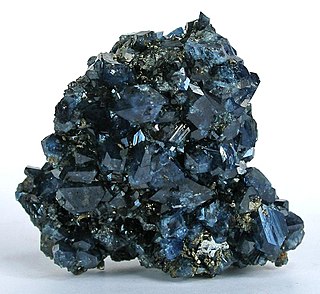
Scorodite is a common hydrated iron arsenate mineral, with the chemical formula FeAsO4·2H2O. It is found in hydrothermal deposits and as a secondary mineral in gossans worldwide. Scorodite weathers to limonite.

Warwickite is an iron magnesium titanium borate mineral with the chemical formula (MgFe)3Ti(O, BO3)2orMg(Ti,Fe3+, Al)(BO3)O. It occurs as brown to black prismatic orthorhombic crystals which are vitreous and transparent. It has a Mohs hardness of 3 to 4 and a specific gravity of 3.36.

Cerite is a complex silicate mineral group containing cerium, formula (Ce,La,Ca)
9(Mg,Fe3+
)(SiO
4)
6(SiO
3OH)(OH)
3. The cerium and lanthanum content varies with the Ce rich species and the La rich species. Analysis of a sample from the Mountain Pass carbonatite gave 35.05% Ce
2O
3 and 30.04% La
2O
3.
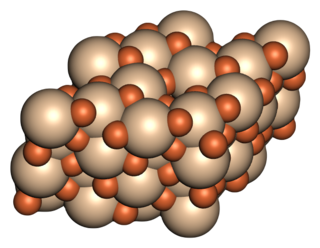
Xifengite (Fe5Si3) is a rare metallic iron silicide mineral. The crystal system of xifengite is hexagonal. It has a specific gravity of 6.45 and a Mohs hardness of 5.5. It occurs as steel gray inclusions within other meteorite derived nickel iron mineral phases.

Clausthalite is a lead selenide mineral, PbSe. It forms a solid solution series with galena PbS.

Titanowodginite is a mineral with the chemical formula MnTiTa2O8. Titanowodginite has a Mohs hardness of 5.5 and a vitreous luster. It is an iridescent dark brown to black crystal that commonly forms in a matrix of smoky quartz or white beryl in a complex zoned pegmatite.
Alloclasite is a sulfosalt mineral. It is a member of the arsenopyrite group. Alloclasite crystallizes in the monoclinic system and typically forms as columnar to radiating acicular prismatic clusters. It is an opaque steel-gray to silver-white, with a metallic luster and a black streak. It is brittle with perfect cleavage, a Mohs hardness of 5 and a specific gravity of 5.91–5.95.

Thomasclarkite-(Y) is a rare mineral which was known as UK-93 until 1997, when it was renamed in honour of Thomas H. Clark (1893–1996), McGill University professor. The mineral is one of many rare-earth element minerals from Mont Saint-Hilaire. The only reported occurrence is in an alkalic pegmatite dike in an intrusive gabbro-nepheline syenite.
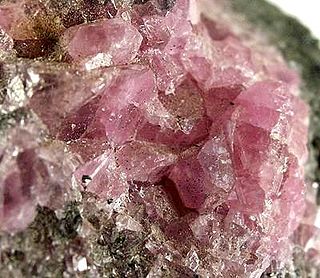
Hodgkinsonite is a rare zinc manganese silicate mineral Zn2MnSiO4(OH)2. It crystallizes in the monoclinic system and typically forms radiating to acicular prismatic crystals with variable color from pink, yellow-red to deep red. Hodgkinsonite was discovered in 1913 by H. H. Hodgkinson, for whom it is named in Franklin, New Jersey, and it is only found in that area.
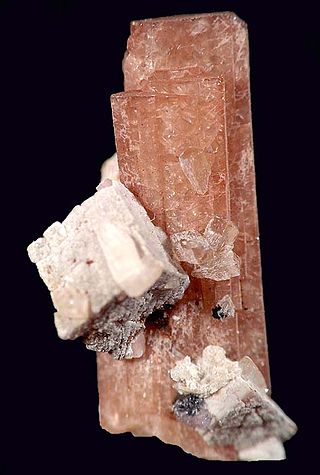
Ancylite is a group of hydrous strontium carbonate minerals containing cerium, lanthanum and minor amounts of other rare-earth elements. The chemical formula is Sr(Ce,La)(CO3)2(OH)·H2O with ancylite-Ce enriched in cerium and ancylite-La in lanthanum.
Altisite (IMA symbol: Ati) is an exceedingly rare alkaline titanium aluminosilicate chloride mineral with formula Na3K6Ti2Al2Si8O26Cl3, from alkaline pegmatites. It is named after its composition (ALuminium, TItanium, and SIlicon).
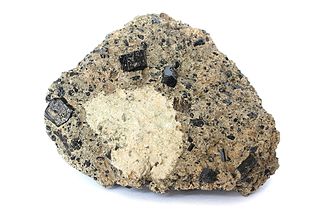
Kaersutite is a dark brown to black double chain calcic titanium bearing amphibole mineral with formula: NaCa2(Mg3Ti4+Al)(Si6Al2)O22(O)2.
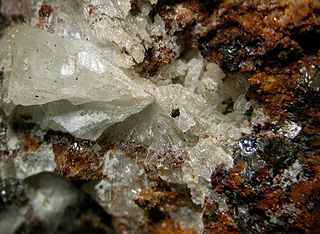
Fluellite is a mineral with the chemical formula Al2(PO4)F2(OH)•7H2O. The name is from its chemical composition, being a fluate of alumine (French).

Corkite is a phosphate mineral in the beudantite subgroup of the alunite group. Corkite is the phosphate analogue of beudantite and with it, a complete solid solution range exists. Corkite will also form a solid solution with kintoreite.

Uranocircite or Uranocircite-II is a uranium mineral with the chemical formula: Ba(UO2)2(PO4)2·10H2O. Uranocircite-I was discredited (the IMA-CMNMC published 'The New IMA List of Minerals', September 2012). It is a phosphate mineral which contains barium and is a green to yellow colour. It has a Mohs hardness of about 2.

Joanneumite, confirmed as a new mineral in 2012, is the first recognized isocyanurate mineral, with the formula Cu(C3N3O3H2)2(NH3)2. It is also an ammine-containing mineral, a feature shared with ammineite, chanabayaite and shilovite. All the minerals are very rare and were found in a guano deposit in Pabellón de Pica, Chile.
References
- ↑ Warr, L.N. (2021). "IMA–CNMNC approved mineral symbols". Mineralogical Magazine. 85 (3): 291–320. Bibcode:2021MinM...85..291W. doi: 10.1180/mgm.2021.43 . S2CID 235729616.
- ↑ http://webmineral.com/data/Brownleeite.shtml Webmineral data
- ↑ http://www.mindat.org/min-36014.html Mindat.org
- ↑ Mindat, http://www.mindat.org/min-38826.html
- ↑ "University of Washington News of Juni 12, 2008". Archived from the original on 2008-07-08. Retrieved 2008-06-14.
- ↑ Newswise: Like a Rock: New Mineral Named for Astronomer Retrieved on June 15, 2008
- ↑ NASA News Releases June 12, 2008: NASA Finds New Type of Comet Dust Mineral
- ↑ Minerals approved by the IMA-CNMNC in June 2008 [ permanent dead link ]
- ↑ Universe Today June 12, 2008: Alien Mineral From Comet Dust Found in Earth's Atmosphere